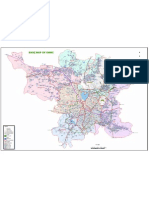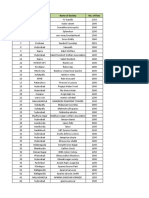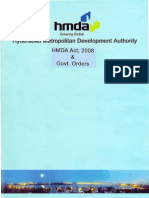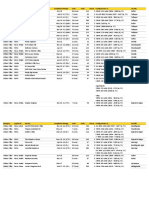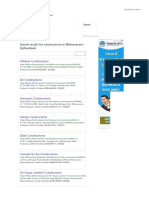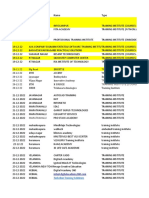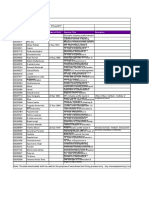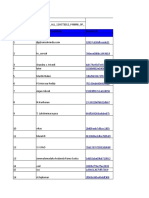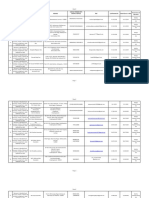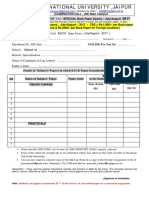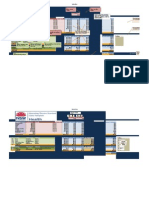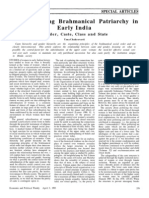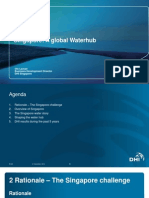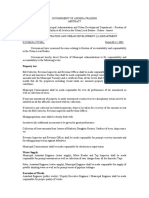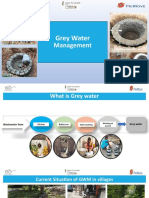Hyderabad Metropolitan Water Supply
Hyderabad Metropolitan Water Supply
Uploaded by
vyshnosudhaCopyright:
Available Formats
Hyderabad Metropolitan Water Supply
Hyderabad Metropolitan Water Supply
Uploaded by
vyshnosudhaOriginal Description:
Original Title
Copyright
Available Formats
Share this document
Did you find this document useful?
Is this content inappropriate?
Copyright:
Available Formats
Hyderabad Metropolitan Water Supply
Hyderabad Metropolitan Water Supply
Uploaded by
vyshnosudhaCopyright:
Available Formats
The Hyderabad Metropolitan Water Supply and Sewerage Board
Introduction
With more than four million residents, the city of Hyderabad is the capital of the southern
Indian state of Andhra Pradesh (Figure 1). It is Indias seventh largest city and one of its fastest
growing. Over the last two decades, the citys population has expanded at an average rate of
over three percent per annum; more recently, this rate has increased to 5.6% per year. Now,
every ten years, 2.2 million more people come to reside in Hyderabad. By 2020, it is expected
that its population will reach 11 million.
1
Andhra Pradeshs dynamic young Chief Minister, Chandrababu Naidu, likes to take credit for
both the growth and the increasing productivity of Hyderabad. Ever since he took power in
1995, Naidu pursued an aggressive strategy of modernization and technology-based
development. He hoped to steal the mantle of Software Capital of India away from the city of
Bangalore, capital of neighboring Karnataka. Recognizing that Hyderabad lacks Bangalores
numerous universities and defense research centers, Naidu aggressively targeted technology-
based businesses to locate in his states capital by promising to provide them world-class
infrastructure. Among Naidus major successes were luring Microsoft to establish its Indian
headquarters in Hyderabad in 1998 and hosting US President Bill Clinton during his whirlwind
visit to India in 2000.
Naidu is proud of his achievements, but he is also worried about the ability of his city to cope
with the roughly 250,000 new people that relocate to Hyderabad each year. He is particularly
concerned about fulfilling his promise of providing high-quality infrastructure to firms and
households. A combination of heavily subsidized pricing for public services and a lack of
adequate investment funds has put tremendous pressure on Hyderabads public agencies. For
several years, Naidu has led a reform effort in Hyderabads public service agencies, encouraging
government employees to become more customer-oriented and professional in their
performance. In his re-election campaign of 1999, Naidu pursued a strategy novel in Indian
politics by openly promising better public services in exchange for higher tariffsa pledge that
won him re-election.
Although many of Naidus reforms have improved performance in Hyderabads public
agencies, they have not fully addressed the key challenge of expanding infrastructure to keep
pace with the rapidly growing city. With encouragement from the World Bank, Naidu has
become convinced that privatization of key utilities is the most expedient solution to
Hyderabads impending infrastructure crisis. He hopes to make the Hyderabad Metropolitan
This case was written by Professor Jennifer Davis of the Massachusetts Institute of Technology and Sunil Tanka for
Henry Lee, Lecturer in Public Policy at the Kennedy School of Government. The research upon which this case is
based was supported in part by Harvards Kennedy School of Government, the UNDP-World Bank Water &
Sanitation Program, South Asia Regional Office, and the Government of Netherlands, Netherlands Partnership
Program. This case is intended to serve as a basis for discussion, and not to depict the appropriate or inappropriate
handling of an administrative situation or policy problem.
1
The designation Hyderabad is used to refer to the adjoining cities of Hyderabad and Secunderabad, located on
opposite banks of the Musi River. The Hyderabad Water Board serves the entire Hyderabad-Secunderabad area.
Unless otherwise noted, all figures (e.g., area, population) refer to this entire metropolitan area. The 2001 Census of
India states the population of Hyderabad as 3,449,878.
Water Supply and Sewerage Board (the Board, or HMWSSB)
2
the first major utility in the
state to be privatized. The Government of Andhra Pradesh and the HMWSSB have sought the
support of the World Bank in moving forward with a concession for the Boards operations.
Whereas the World Bank is supportive of Naidus privatization plan, Bank officials are
concerned that benefits of this reform be shared by Hyderabads roughly 1.7 million slum-
dwellers.
3
Experience with other privatizations has made the World Bank increasingly sensitive
to the facts that (1) water supply and sanitation are viewed as having more public benefits than
any other infrastructure sector, and (2) given the high cost of service and the pressure to supply
low-income households at very low prices, private operators will understandably resist extending
service into slum areas. In order to receive technical and financial assistance in the privatization
process, the Bankalong with many local NGOs and consumer rights organizationsis
insistent that Naidus team devise a strategy for privatizing HMWSSB that addresses service to
Hyderabads poor.
Naidu has appointed M.G. Gopal, an industrious civil servant known for his successful
management of the Andhra Pradesh Tourism Development Corporation hotels privatization, as
Managing Director of HMWSSB. Gopal understands that, to prepare the organization for
privatization, he must balance the competing demands of making the HMWSSB attractive to
private investors while ensuring that the interests of the poorer residents of Hyderabad are
protected. He has identified three alternative approaches, none of which appears completely
satisfactory.
First, the private concessionaire could be made responsible for extending service to the poor
at a controlled price, with a regulator ensuring strict investment and network expansion
schedules. A second option is to allow the concessionaire to choose the neighborhoods in which
it will meet expansion targets; under this arrangement, poor communities will likely be served
only when they are willing and able to pay for service improvements. A final option is to give
principal financial responsibility for water and sanitation services for poor households to the
Municipal Corporation of Hyderabad, which already plays a role in providing infrastructure
services to the citys slums. The Corporation could fund expansion of water and sewerage
services to poor neighborhoods through tax revenues and foreign aid. This strategy would
formalize an arrangement that already exists in practice in many slums, and would also spare the
concessionaire the responsibility of servicing a large and commercially unviable population.
Which strategy should Gopal recommend in order to satisfy World Bank officials and
execute a successful privatization of HMWSSB? Is there a way to balance both commercial and
social objectives in the privatization of essential services, such as water supply and sanitation?
2
The two terms are used interchangeably in this text.
3
In Hyderabadas in most Indian citiesthe term slum is an administrative designation used to refer to a wide
variety of informal housing settlements comprising poorly built congested tenements, an unhygienic environment
usually with inadequate infrastructure and lacking in proper sanitary and drinking water facilities (Census of India,
2001). Communities designated as slums (a classification known as being notified) are entitled to an array of
public assistance, such as subsidized water supply connections. In addition to designated slums, there are a number
of illegal squatter settlements in Hyderabad that are not entitled to public assistance; indeed, it is unclear whether
public agencies are legally permitted to provide services to these communities. In Hyderabad, estimates of the
number of slum dwellers range between 1.2 and 2 million (the case uses the figure 1.7 million).
2
Background
The HMWSSB is a relatively young institution. The state government had hoped that it
would defy the stereotype of a South Asian bureaucracy by operating as an autonomous agency
but under commercial principals. The Board was created in 1989 by consolidating two existing
government departments. Previously, the state-level Public Health Engineering Department had
been in charge of water services for the city, while the Municipal Corporation of Hyderabad
(MCH) was responsible for sewerage services.
The re-organization was encouraged by the World Bank as a means of establishing a water
and sewerage authority with greater financial and operational autonomy, as well as heightened
accountability to customers. In turn, it was hoped that the Board would move toward cost
recovery through user fees, which would both free it from political interference and generate a
substantial proportion of the resources needed to augment bulk water supply. Indeed, the Act
creating the Board stipulates that it be financially self-sufficient through user fees. As a first step
in this direction, the HMWSSB achieved virtually universal metering of its customers by 1992.
Despite clear mandates in the Boards charter, the HMWSSB enjoys neither budgetary nor
personnel management autonomy. When the organization was formed in 1989, the Government
of Andhra Pradesh retained ownership of the Boards assets. The Chief Minister of Andhra
Pradesh (Naidu) serves as Chairman of the agencys Board of Directors (Figure 2). Virtually all
members of the Board of Directors, including the Managing Director of the Board itself, are
political appointees. Naidu oversees all important and politically sensitive policy decisions, such
as tariff rates, and leaves the operations of the Board to the Managing Director. The Managing
Director is a member of the Indian Administrative Service, the elite wing of Indian bureaucracy.
4
In addition, only a minority of staff actually became official employees of the Board; the rest are
still staff of the state Public Health Engineering Department and are subject to its personnel
management policies for matters of promotion, transfer and benefits.
A review of the Boards balance sheets suggests that the HMWSSB is making slow progress
toward financial self-sufficiency (Table 1). In 2001, user fees and new connection charges
combined did not cover even operations and maintenance (O&M) and staff costs. In fact,
between 1989 and 2002 tariffs were only raised twice, by 17% in 1993 and by 25% in 1997.
During this same period, however, inflation in India averaged 8.5% per annum. In early 2002,
the Board finally won approval for a sizeable (64%) increase in tariffs. User fees are now
expected to cover O&M costs, but not depreciation, system rehabilitation or new investments
(Table 2). Each year the government of Andhra Pradesh provides support in terms of grants-in-
aid to the Board. For accounting purposes, these grants are treated as contributions either to the
HMWSSBs capital base or to operating expenses.
The Board has also recently re-structured its tariffs for water and sewerage service.
Differential pricing for industrial, commercial, and residential customers has been eliminated.
Instead, an increasing block tariff is designed to allow cross-subsidy of domestic customers by
commercial and industrial enterprises that use larger volumes of water. It is unclear how these
4
The Indian Administrative Service is an elite national-level arm of the Indian Bureaucracy. Admission to the ranks
of the IAS occurs through a competitive examination and interview process. IAS officers are protected by the civil
service rules of India, and can be dismissed only if convicted of crime while in office. IAS officers are well paid by
Indian bureaucratic standards, and enjoy considerable power and fringe benefits associated with their positions. IAS
officers also have the potential of being deputized to international organizations such as the United Nations and the
World Bank.
3
tariff revisions will affect the relative burden of cost-recovery among different user groups.
Historically, domestic customers have used more than 60% of the water provided by the Board,
but generated only about 30% of the Boards revenues (Figure 4).
Tariffs have been kept low in response to pressure from elected officials who view water as a
social good that should be provided at low or no cost to residents, particularly the poor. In
reality, it is low tariffs that restrict the Boards ability to expand its infrastructure to low-income
settlements where poor residents live. Middle- and upper-class households with individual piped
water connections benefit from this subsidized service, while poor households are often forced to
rely on public standposts or on water vendors.
Another reason that the Managing Directors requests for tariff increases have been rejected
by the Chief Minister and the Board of Directorsdespite strong World Bank support for tariff
reformis the high level of unaccounted for water in Hyderabads system. Estimates range
from 40-55% of supply, with roughly 40% thought to be physical losses and 60% administrative
losses (Figure 5).
5
Before many political officials will support tariff increases and investments in
new supply, they insist that the Board improve the management of the resources they already
control. If they reduce the level of non-revenue water, they will automatically get a substantial
increase in their revenues, notes one member of the Board of Directors who has repeatedly
opposed water tariff increases. The customer should not have to pay for the HMWSSBs
inefficiency.
A former Managing Director noted, however, that the infrastructure the Board inherited from
the Public Health Engineering Department in 1989 was in poor condition, especially in the older
parts of the city. Rehabilitating the network such that a substantial reduction in unaccounted for
water is achieved will require a sizeable investment.
6
Further, Hyderabads politicians obstruct
efforts to dismantle illegal connections and to disconnect households who have not paid their
water bills. Board staff who attempt to enforce such penalties often find themselves transferred
to a penalty post in an undesirable department. In some cases, local leaders have even
organized residents to confront and threaten Board staff attempting to enforce disconnection
rules. Given the Boards difficulty both in setting reasonable tariffs and enforcing payment from
users, it is not surprising that its service levels have been declining over the past several years.
Water & sanitation services in Hyderabad
Like other cities in Southern India, Hyderabad is severely water-constrained. In part, this is
the result of water resources management decisions by the Government of Andhra Pradesh;
agricultural interests near Hyderabad exert control over a substantial proportion of the regions
surface water. In addition, whereas many other parts of India experience heavy regional
precipitation during the monsoon months (J une-September and December-J anuary), Hyderabad
receives comparatively little monsoon rainfall. Average annual precipitation in the city is only
about 78 cm., much less than the 163 cm. in Calcutta and the 225 cm. in Bombay.
5
Administrative losses include all water used by customers for which the Board receives no revenue, including
water that is stolen or insufficiently billed, as well as water provided free of charge by the Board such as through
public standposts or tankers.
6
No reliable cost estimates for UFW reduction are available. In one recent project, the Board spent Rs. 270 million
(US$5.5 million) to rehabilitate 27 kilometers of transmission line extending from one of its reservoirs into the city.
4
Hyderabad has become accustomed to living on the brink of thirst. Currently, unrationed water
demand (the amount of water that would be demanded if continuous supply were available) in
the metro area is estimated at 1,700 MLD and is expected to increase to over 2,000 MLD by
2011 and 2,600 MLD by 2021. In contrast, the current water supply capacity of the Board (755
MLD) is just over half of rationed demandthe water needed to provide two hours of supply per
connection per day (approximately 250 liters)a total volume of 1,300 MLD (Figure 2). City
residents will experience severe water supply shortages if substantial infrastructure investments
are not undertaken soon.
For several decades Hyderabad relied on two small reservoirs for its water needs: Osman
Sagar, built in 1920, supplies the city 114 millions of liters per day (MLD) and Himayat Sagar,
built in 1927, supplies an additional 68 MLD. After years of severe water shortages, the city
finally managed to build a series of dams on the Manjira River, which gradually increased the
citys water supply by an additional 473 MLD. The city also manages to pump out an additional
100 MLD of groundwater, although the majority of groundwater near Hyderabad is not potable.
The total volume withdrawn, 755 MLD, however, is still several hundred MLD short of demand.
Indeed, households are supplied water for only about two hours per day when the rains have
been abundant; when the rains fail, this two-hour supply is provided only every other day.
Larger commercial and industrial users have had to make other arrangements for their water
supply. Most rely on private water vendors who deliver water pumped from agricultural lands
outside of the city in tankers, charging an average of Rs. 50 (US$1.05) per cubic meter (m
3
).
7
The prospects for future investment, given current financing options, are not favorable. The
funds that Hyderabad has obtained through loans from national development agencies and banks
such as the Life Insurance Corporation of India and the Housing and Urban Development
Corporation have been insufficient to finance the kind of large-scale investment in water supply
that the city needs. The Krishna Water Project, which is designed to bring in an additional 410
MLD to the city at a cost of Rs. 10 billion (~US$ 208 million), was recently approved by the
state government after being delayed for years. This initiative, however, will more than double
the average cost of production from Rs. 11.3 (US$0.24) to Rs. 25 (US$0.52) per m
3
.
Analysts have also noted two alarming trends regarding water infrastructure investments for
Hyderabad.
8
First, the time period between water source development projects is becoming
progressively shorter, suggesting that the regions accessible and affordable bulk water sources
have already been developed. To keep pace with population growth, the city will need to
identify and develop new supply sources almost continually. Second, the distance between bulk
water sources and the city has increased with each project, indicating escalating costs per unit
volume (as well as increasing transmission losses). Hyderabad is becoming increasingly reliant
on water from the Krishna and Godavari rivers, which are at distances of 110 km. and 200 km.
(68 and 124 miles), respectively, from the city. Given the pressing need for investment and the
supportive position of the World Bank, Chief Minister Naidu is looking to privatization as the
solution to Hyderabads looming water supply crisis.
7
US$1 =Rs. 48. One cubic meter =1,000 liters. 3.87 liters =1 gallon.
8
Saleth, R.M., and A. Dinar. 1997. Satisfying urban thirst: Water supply augmentation and pricing policy in
Hyderabad, India. World Bank Technical Paper No. 395. Washington, DC: The World Bank.
5
Service to the Poor
Among the Hyderabad residents suffering from a lack of water and sanitation services, the
citys 1.7 slum dwellers are the most seriously impacted. Most middle- and upper-class
households have installed borewells that provide low-quality groundwater for bathing and
washing, but slum dwellers typically cannot afford this investment.
9
The official poverty line for
the city is Rs. 1500 (US$31). Average daily wages for unskilled labor range between Rs. 60 and
80, which means a laborer with a full-time job would earn roughly Rs. 1400-1750 per month.
10
Other researchers working in Hyderabad have estimated that total monthly income for
households in slums is approximately Rs. 3,000-5,000 (US$63-104) on average.
Currently, water supply and sanitation lines (trunk mains) extend into roughly half of the
citys slums, principally the result of a project funded by the British Overseas Development
Authority. No reliable estimates are available regarding the proportion of slum dwellers in these
areas that have individual water and sewer connections, but anecdotal evidence suggests that it is
no more than half. Officials at the HMWSSB estimate that another Rs. 540 million-1 billion
(US$11-21 million) will be needed to extend services to the citys unserved communities.
11
In
the meanwhile, poor households rely on nearby public standposts or borewells, or on water
provided through HMWSSB tanker trucks. According to the Board, tankers provide
approximately 40 liters per capita per day free of charge to slum dwellers lacking network
infrastructure. The Board currently leases about 250 tankers, most of which carry 5,000 liters of
water, for Rs. 25,000 (US$520) per month. Still other residents in slums without network
infrastructure rely on service theft to meet their water supply needs. HMWSSB staff estimate
that as many as 10,000 public stand posts have been constructed illegally in slums, and the Board
typically turns a blind eye to their existence. One senior official said he would not be surprised
if one third of the HMWSSBs unaccounted-for water was stolen by poor households.
HMWSSB does make network connections more affordable for poor households by
participating in the National Slum Development Program. The program provides a federal
subsidy of 50% of the connection charge (approximately US $115) for households located in the
citys approximately 800 designated slum neighborhoods. The charge can also be paid in
installments over a five-month period without interest. There are, however, no subsidies
available for sewerage connections. Between 1992-1998 the Board also undertook, on the
insistence of the World Bank, a large low-cost sanitation initiative that involved building over
20,000 twin-pit pour-flush latrines in outlying slum neighborhoods as part of a larger Bank-
funded water and sanitation project. As a result of reported groundwater contamination from the
installed latrines, however, the Board has since decided not to construct additional on-site
sanitation facilities unless there is virtually no prospect of extending sewer lines to a particular
community.
9
The Board receives no payment for private abstraction of groundwater, nor are residents required to obtain a permit
for borewell drilling.
10
The Government of Andhra Pradesh estimated average per-capita monthly income in 2001 for the entire state to
be Rs. 800 per month (US$17). However, reliable income data for Hyderabads poor are not available, and slum
residents have an incentive to understate their earnings to retain eligibility for social services such as food ration
cards.
11
Note that this figure pertains only to official slums; it is believed that another 300,000-400,000 residents live in
unregistered slums within the greater metropolitan area. At this time, the Board has no official obligation to serve
these unplanned settlements.
6
In addition, although more than 6,600 public standposts are located in the citys slum areas,
senior staff of the HMWSSB have made an informal commitment to phase out their
servicing.
12
This decision stems primarily from the fact that each standpost, which supplies
water free of charge to residents, is a loss-making venture for a Board scrambling to improve its
financial standing.
13
Representatives from some of the citys major NGOs active in health and
slum upgrading were virtually unanimous during interviews that the Board is not working in
slums in any sincere way. Indeed, in 1997 estimates were that the Board provided an average
of approximately 135 liters per capita per day (LPCD) to non-slum households, but only 20
LPCD to slum households served by public standposts.
14
Some of the Boards policies are actually detrimental to low-income customers. For
example, only individual water and sewer connections are available. Households that want to
share a connection pay a higher fee.
15
The rationale for this sharing penalty is that connections serving multiple households will
suffer greater wear and tear, requiring more frequent servicing by the Board and thus justifying a
higher initial fee. For industrialized country settings, this rationale might be sound; however, in
Hyderabad, where water supply through the Boards network is available only a couple of hours
per day at most, the argument is less convincing. In fact, a senior Board officer remarked,
When people tell me that they want to apply for a shared connection, I tell them just to put it in
one persons name and work out the sharing among themselves. Although no reliable figures
are available regarding the number of households that use this arrangement, one staff member
working in the new connections office estimated that he receives two to three queries about
shared connections each week.
The fact that the HMWSSB is not giving concerted attention to facilitating new connections
for poor households is not particularly surprising. Section 8 of the Act creating the Board
stipulates that it be financially self-sufficient through user fees; given the restrictions on
domestic tariff increases and the perception of non-payment problems in low-income
neighborhoods, slums do not hold substantial revenue potential. Nor do slum dwellers have the
degree of political pull of more affluent residents in Hyderabad. At the same time, a variety of
slum development programs in Hyderabad, implemented primarily through the Municipal
12
Previously, the Board established a program of public standpost conversion in the citys slums whereby a group of
households was required to organize and assign a leader to collect monthly payments from all users. This system
was shut down by agitation from Members of the State Legislative Assembly (MLAs), who said that poor
households receiving such a low level of service should not be charged at all.
13
There is tension between the HMWSSB and the Municipal Corporation of Hyderabad (MCH) regarding which
institution has responsibility for O&M of public standposts, and over fees owed for the supply of water to the PSPs.
Reportedly, both organizations signed an agreement in 1989 by which the MCH would reimburse the HMWSSB for
all water supplied free of charge to city residents. After several years, however, the Corporation ceased its payments
for this service.
14
The World Health Organization uses a norm of 50 LPCD for basic needs, including drinking, cooking, and
hygiene.
15
This is the result of the Boards use of plot area to determine the price it will charge customers for new water and
sewer connections. For example, a household with a plot area of 101-200 m
2
pays Rs. 5,250 (~US$115) for a half-
inch water/sanitation connection. If the household wants to collaborate with its neighbor on a shared connection,
and if the neighbor has a similar plot size, the cost of this same connection would increase to at least 1.5 times the
price, Rs. 8,250-16,500, (US$180-365).
7
Corporation, provide alternative mechanisms for low-income households to receive improved
services.
16
One of the Municipal Corporations key subsidiaries, the Urban Community Development
(UCD) department, is the lead agency for most slum upgrading programs in Hyderabad. The
department implements a range of activities for poor neighborhoods, including micro-credit and
employment schemes, womens and childrens health programs, and infrastructure improvement
initiatives. The UCD has been the primary partner in several large slum upgrading projects, and
has implemented partnerships between the UCD and several community-based organizations that
help residents establish and implement development priorities. Because it is short of staff,
resources, and political influence, the UCD has largely employed a project orientation in its
activities, taking advantage of opportunities to partner with city NGOs and bi- and multilateral
organizations. Whereas these efforts reach only a fraction of the citys poor, they have arguably
helped the Board to shift responsibility for water and sewerage planning in Hyderabads slums
onto other organizations, thereby freeing it to focus on commercially viable customers.
Reforms at the Board
The emphasis on corporatizing the HMWSSBs operations is, in part, linked to the political
infeasibility of tariff increases. In 1997, the Board launched a series of initiatives designed to
improve operational efficiencies and customer service. The Chief Minister felt that the Board
would need to make some initial efforts to improve its performance if it was to generate public
acceptance for higher tariffs. Of course, given the Boards financial position, the Managing
Director (MD) knew that he could not address customers principal source of dissatisfaction
the inadequate supply of water. Thus he began to look for strategies to improve the Boards
image that did not require large expenditures.
To engender an attitude of customer service, the roughly 120 engineers heading the Boards
section officesthe critical point of interface between the Board and its customershad their
titles changed from Assistant Engineer to Manager, although their responsibilities remained
essentially the same. All Board staff at this and higher levels underwent training on topics such
as complaint resolution and customer satisfaction. Many were sent on training visits to water
utilities in Australia, England and Singapore. Next, a series of customer-service programs, many
of which were adopted from agencies in these countries, was implemented at the Board.
One of these programs, the Metro Customer Care Initiative (MCC), centralized and
computerized customer complaints to the Board. Previously customers had filed complaints in-
person at the local sector office. The MCC initiated a hotline that allows customers to call a
toll-free number to lodge their complaints. Trained operators in the MCC office at Board
headquarters log each complaint into a computer and relay it directly to the area manager in
whose jurisdiction the customer lives. Once the area manager addresses the complaint, his
customer signs a compliance report and the matter is coded as resolved in the MCC system.
16
The Municipal Corporation of Hyderabad (MCH) is a local body, established in 1955, that is responsible for
installing and maintaining public infrastructure such as roads, bridges, water and sewer networks, and street lighting;
for managing several hundred parks and playgrounds; and for operating many other public facilities, such as
stadiums, urban health posts, and slaughterhouses. The MCH has more than 10,000 employees and is headed by a
Commissioner. The Commissioner is an officer of the Indian Administrative Service (see footnote 3) and is
appointed by the Chief Minister, typically for a two- to three-year term. The MCH also has a Standing Committee
comprised of elected officials from the citys 100 wards, which, along with the citys mayor, oversees the budget
and activities of the Corporation.
8
Information from the MCC database is used to generate an efficiency rating for each area
manager, which is computed by dividing the number of complaints s/he received in a given
month that were resolved within the target time frame by the total number of complaints s/he
received during the period (Table 3). Efficiency ratings are reported monthly to the Managing
Director, and are also displayed publicly on computer terminals in various Board offices (Figure
6). General Managers and the Managing Director have been very active in monitoring these
ratings and managers are keenly aware that their performance is being monitored in this manner.
Another initiative of the Board was to consolidate the procedures involved in applying for
new water supply and sewerage connections with its Single Window Cell and Green Brigade
initiatives, launched in 1998. Previously, a customer was required to visit at least five different
offices to obtain the necessary sanctions and permits for a new water and sanitation connection.
The customer was also responsible for hiring a plumber to complete the in-house plumbing for
the connection. The Single Window Cell centralized the application procedure at the Boards
headquarters, where customers must now come to file an initial application and deposit, and
return to pay the balance of their accounts once their connection is installed. The Board handles
all other functions, such as land surveying and obtaining road-cutting permits. The Green
Brigade is a specialized corps of technical employees charged with installing new water and
sanitation connections for the Board.
The Single Window Cell and Green Brigade have improved the Boards processing of new
connections in many ways. All information about new connections is now computerized,
allowing senior Board officials to access data regarding areas of increasing demand quickly and
easily. Time demands on customers have been reduced substantially. Requiring the use of the
Green Brigade for connection installation ensures high quality work and helps in the detection of
illegal connections. The Single Window Cell has received favorable press coverage in
Hyderabad, and customers appear to appreciate this new convenience. In a survey of 50
customers who obtained connections through the Cell in past six months, 70% said they were
very satisfied with their experience. Still, it is paradoxical that the Board has made obtaining a
new connection simpler at the same time that per capita water supply is dwindling. As one
senior engineer said when explaining why the Board does not ration new connections given the
citys water scarcity problem:
Of course we will give them the connection. Let them pay the fee and we will give them a
connection, quickly. But we cannot guarantee that there will be water in that connection! We
want to supply the service, and we do not want to wait until [the new water source development
project] to give people their connectionsMaybe these customers will help us to apply
pressure for new projects.
The Board has also tried to combat the publics lack of trust in government agencies with a
proactive communications strategy and a Citizens Charter. The Charter, developed in 1999 by
the Boards management, is distributed to all customers and outlines the rights and
responsibilities of the Board and its customers. The Charter specifies service standards for
Board customers, including the provision of at least 250 liters of water per connection per day,
17
advance notification of any changes in water supply schedules and amounts, and timeframes
within which the Board is required to redress customer complaints (Table 3).
17
This volume is a little less than the average Indian water utility supplies. By way of comparison, in Buenos Aires,
Argentina water use is approximately 600 liters per person per day.
9
The idea behind all these initiatives was to build public support for the Board that could be
translated into acceptance of tariff increases. We must move first, explained an official at the
Board. We have to re-gain the trust of the public. They must understand the problems we face.
When they know how we are trying, and what is required [to improve service], they will support
our proposals [to increase user fees]. It is also true, of course, that such measures will make the
Board more attractive to potential bidders for a concession contract. These are the kinds of
reforms that a private operator would undertake as soon as [it] took over a utility, one World
Bank staff member noted. Its even better for the privatization if they are done in advance.
Comparatively, Hyderabad looks very attractive to bidders.
Impacts on poor customers
The World Banks support for the Boards institutional reforms might wane if Bank officials
recognize the detrimental effects that some of these measures appear to have had on low-income
households. The Boards increased reliance on information technology in the processing of new
connection applications, for example, has reaped impressive results for the HMWSSB overall.
At the same time, whereas roughly a third of the Boards customers reside in slum
neighborhoods, fewer than 10% of calls to the Boards hotline are made by slum residents.
Clearly this finding is not the result of slum residents having better water supply and sanitation
services than non-slum areas. It is likely a result of the relative prevalence of telephones in the
two neighborhood types. The Board staff point out that the hotline is a toll-free call; households
without telephone service can theoretically make this call free of charge at any commercial
Public Call Office in the city. Anecdotal evidence, however, suggests that booth attendants
regularly refuse to place such calls without payment. Moreover, many observers have noted that
slum dwellers have little experience lodging telephone complaints, and usually no experience
with the type of automated touch-tone system used by the Board.
These findings would not be so troubling if the HMWSSB operated a mixed system of
complaints registration that allows poor households a different but equally effective means of
reporting service problems to the Board. Residents do still have the option of filing complaints
in person at one of the citys approximately 120 section offices, and anecdotal evidence suggests
that this is the route taken by lower-income customers. However, section office managers are
faced with strong incentives to give priority to complaints submitted through the telephone
hotline. The monthly efficiency ratings by which managers performance is evaluated are
calculated using only data from hotline complaintsin-person complaints are ignored. In fact,
section managers have been instructed to use the hotline themselves, i.e., to phone in any
complaints they receive from customers who arrive in person at their offices. More than one
third of managers admitted during a recent survey that they never register these complaints with
the hotline.
Managers thus have no incentive to log complaints on behalf of customers who lodge them in
person at the section office; if anything, they have a significant incentive not to log them. All
else held equal, the fewer complaints a manager has logged with the hotline, the easier it is to
earn a good efficiency rating. To the extent that in-person filers are lower-income consumers,
the Boards increasing reliance on information technology for complaints management and staff
performance evaluation is exacerbating the gap in responsiveness to O&M problems between
poor and non-poor households.
Looking Toward Privatization
10
Chief Minister Naidu appreciates his Managing Directors efforts and has supported him with
a recent (but vociferously opposed) tariff hike. However, Naidu recognizes that it will be some
time before additional tariff increases can bring revenues in line with the Boards expenditures.
Continued subsidies to the Board are eating into Naidus scarce state development resources, and
progress toward his goal of world-class infrastructure in Hyderabad is slow. Several
international water and sanitation (W&S) companies, especially the several firms from France,
are particularly interested in breaking into the Indian market. When efforts to privatize
Bangalores water utility were stalled, Naidu began to consider becoming the pioneer in India
with W&S privatization. Hyderabad could become the first Indian city to have a privately
operated water and sanitation system.
For Naidu, privatization would solve a lot of problems. While the internal reforms at the
Board have improved performance, they also seem to have reached their full potential. More
importantly, the shortage of investment capital for W&S infrastructure persists. A successful
businessman himself before entering politics, Naidu is confident in the private sectors ability to
raise investment and service levels for the benefit of customers. He also feels that the tariff issue
could be more easily handled once a regulatory commission is established. Naidus concern now
is that the Boards privatization generates enough interest from investors to secure financial
terms sufficient to have the effort considered a success. This responsibility has been placed on
the shoulders of M.G. Gopal, the Boards new Managing Director.
Gopal views the potential privatization of the Board as an opportunity to energize his career.
If he succeeds, more prestigious postings will come to him, perhaps even a deputation to an
international organization like the World Bank. However, if he fails or the process gets mired in
political controversy, he might easily find himself sidelined with an unfavorable transfer.
Gopals initial meetings with the Chief Minister have been encouraging. Naidu wants him to
consolidate the reforms that the Boards previous Managing Directors instituted with the goal of
making the organization as attractive as possible to foreign investment. He conveyed his desire
to privatize the Board and promised Gopal all the necessary support. However, Gopal realizes
that, despite the Naidus assurances, privatizing the Board will not be an easy task.
First, the Boards un- and semi-skilled workers are organized.
18
India has a history of strong
labor movements, enmeshed with political parties, which have often stymied reform efforts.
Given the countrys highly protective civil service rules governing hiring and firing and the
powerful labor unions that have demonstrated their willingness to strike at the slightest
provocation, public sector managers have to tread delicately when disciplining errant employees
or even in trying to reward outstanding performance.
19
At the Board, labor relations are best
described as cordial but strained. For several years, the state government has maintained a hiring
freeze at the Board, which has reduced staff numbers through attrition by retirement.
20
However,
the union that represents the Board employees has been strenuously protesting this attrition. The
prospect of layoffs following privatization is sure to galvanize stronger protests.
18
Among the HMWSSBs 5,500 employees, 350 are professional engineering staff.
19
For example, in 1998, the Boards Managing Director tried to reward a few of his best performing managers with
cash bonuses. Other managers challenged this move in court, however, and successfully prevented the MD from
paying out the bonuses.
20
The HMWSSB has approximately 5,500 employees, with 500 vacant posts, for roughly 380,000 connections. The
connection/staff ratio is thus not particularly impressive, even as compared against other water boards in India. The
HMWSSB has roughly 1.8 times the staff of the Chennai or Bangalore water boards for roughly equivalent services
(Franceys and Sansom, 1999). With a current hiring freeze on most posts, however, the ratio is improving as
roughly 200 staff members retire each year.
11
Second, Naidus political opponents have already demonstrated significant power in fighting
rate hikes for public services. For example, Naidu backed the creation of a Regulatory
Committee on Power Tariffs for the state electricity board, which approved a tariff increase in
the summer of 2000. The rate hike was met with swift and vocal demonstrations mobilized by
Naidus political opponents. After weeks of protests that occasionally erupted into violence,
Naidu prevailed upon the regulator to roll back the increases. Privatization of the Board will
clearly prompt a strong response from the opposition.
Finally, and perhaps most difficult, Gopals need to respond to the insistence of the World
Bank and locally based organizations that the Board cannot continue to ignore access to basic
water and sanitation services by Hyderabads 1.7 million poor. Among all the challenges before
him, Gopal feels reasonably confident that he can manage labor and political opposition and deal
effectively with potential investors. He is worried, however, about improving services to the
poor. Without sincere efforts in this area, Gopal is convinced that the World Bank will not
provide the support for privatization that the Board needsand civic organizations will bring
their discontent to the media. In this area Gopal has more concerns than ideas: improving
services for poor households is a challenge that he feels ill-equipped to tackle.
Conclusions
For M.G. Gopal there are difficult choices to make in balancing the needs of making the
concession attractive to the private investors and ensuring that he does not lose World Bank and
popular support in the process. Ideally, there should be a universal service obligation imposed
upon the concessionaire. However, these requirements could make the venture unattractive to
potential bidders; the concessionaire would also have to be allowed a significant tariff increase
so as to make the expansion commercially viable. Poor households might simply refuse to pay
higher prices for service, which would lead to high disconnection rates by the private operator.
Gopal is well aware of the potential for political and civil opposition under this scenario.
Less ideal but more practical would be to fix a coverage expansion schedule while allowing
the concessionaire flexibility to choose where such expansion will occur. This approach would
be most attractive to potential bidders, but it would likely result in a large number of the poor
continuing to be excluded from the Boards W&S network for quite some time. Would the citys
political leaders, who have tolerated this situation for many years, now have an incentive to
mobilize active resistance when a private operator takes over the Board?
Finally, Gopal could recommend that service to the slums be the responsibility of the
Municipal Corporation of Hyderabad (MCH), and that the Corporation fund expansion of water
and sewerage services to slums through its tax revenues and its foreign aid programs. Gopal
could argue that it is the MCH, not the Board, that reaps the majority of benefits from water and
sanitation infrastructure improvements (e.g., increased revenue from escalating property taxes).
Nevertheless, this proposal would likely garner resistance from a number of stakeholders,
particularly the Corporation itself.
A meeting with the World Bank team that will assist the Board in preparing its privatization
strategy is looming, and Gopal must evaluate the three strategies quickly. The Bank team insists
that the Board enunciate a clear strategy for service delivery to the poor as part of its
privatization effort. It has not been happy with the Boards record on this issue so far. Gopal
realizes that without a credible strategy, the Bank will withdraw its support for the privatization
12
program, and the initiative will almost certainly fold. Gopal must therefore draft a pro-poor
proposal that thoroughly addresses the Banks concerns.
13
Figure 1: Location of Hyderabad, Andhra Pradesh, India
14
Figure 2: Water supply and demand in Hyderabad, 1996-2021
0
500
1000
1500
2000
2500
3000
1996 2001 2006
(est'd.)
2011
(est'd.)
2016
(est'd.)
2021
(est'd.) Source: HMWSSB
M
i
l
l
i
o
n
s
o
f
l
i
t
e
r
s
/
d
a
y
Supply
Rationed demand
15
Figure 3: HMWSSB Organizational chart
Functional Interaction
DIVISION
SUB DIVISION
SECTION
Managing Director
Director (Technical) Director (Projects) Director (Finance) Director (Personnel)
Chief General Mgr.
General Manager
Deputy General
Manager
Manager
Water Supply &
Sewerage (O&M)
CONSUMER
Figure 4: HMWSSB customer data, 2000
0 10 20 30 40 50 60
Domestic
Commer./Indust.
Bulk
Public standposts
% revenues
% of water used
Source: HMWSSB
16
Figure 5: Unaccounted for water, HMWSSB
Transmission
15%
Distribution
10%
Supply
66%
Revenue
9%
Source: HMWSSB
Figure 6: Public terminals display HMWSSB manager efficiency ratings
Source: Davis et al., 2001
Figure 7: Breakdown of expenses, HMWSSB
Depreciation
10%
Staff
21%
Interest
20%
Other O&M
12%
Chemicals
1%
Power
36%
17
Table 1: Revenues and expenditures, HMWSSB (FY 2001)
Income (Rs. 100,000s)
Water charges 9201.95
Sewerage charges 2020.14
New connection charges 1326.70
Interest 10.38
Other income 382.00
Total 12,941.17
Expenditures (Rs. 100,000s)
Operations 7000.24
Staff 5616.94
Administration 1348.00
Depreciation 1367.00
Finance charges 1047.00
Total 16,379.18
Less: Expenses capitalized 1450.00
Less: GOAP grants 424.00
Total 14,505.18
Net worth
Contributions from GOAP:
Toward net value of assets 14,439.92
In cash by way of grants-in-aid 44,220.65
Toward improvement reserve 3.13
Less: (Expenditures-Income) (3,381.19)
Total 55,282.51
Breakdown:
Fixed assets 57,531.86
Investments 225.00
Cash, debts owed 3,516.43
Liabilities (LIC, HUDCO loans) (5,990.78)
Source: HMWSSB, 2002
18
Table 2:Water supply and sewerage service and connection charges, HMWSSB (2002)
(All fees in Rs.; US$1=Rs. 48)
Monthly service charges
For monthly usage <500 m
3
Prices for tankers
Rs. 6 / m
3
for <30 m
3
5,000 <m
3
: Rs. 250
Rs. 10 / m
3
for 31<200 m
3
9,000 <m
3
: Rs. 360
Rs. 25 / m
3
for >200 m
3
Monthly meter charge
For monthly >500 m
3
For 15 mm (1/2) diameter connections: Rs. 15
Rs. 25 / m
3
for all consumption For 20 mm (3/4) diameter connections: Rs. 30
For 25 mm (1) diameter connections: Rs. 50
Minimum monthly service charges
21
For larger connections: Rs. 15 for each 5 mm of diam.
For 15 mm (1/2) diameter connections: Rs. 90
For 20 mm (3/4) diameter connections: Rs. 270 Monthly service charge (billing, collections, etc.)
For 25 mm (1) diameter connections: Rs. 600 Rs. 6 per inch diameter of connection
For 40 mm (1.5) diameter connections: Rs. 1,500
For 50+mm (2+) diameter connections: Rs. 3,200
Size of
connection
Plot area
(meters
2
)
Connection charge
1 2 3 4 5 6
Areas with HMWSSB sewerage Other areas
Fixed
amount
Additional charge per m
2
in excess of minimum
plot area in column 2
Fixed
amount
Additional charge per m
2
in
excess of minimum plot
area in column 2
15 mm
(.5 in)
0<80
80<200
200<300
300<400
400+
2500
8250
8250
16,500
24,000
0
0
82.50
75.00
60.00
1,250
5,500
5,000
11,000
16,000
0
0
55.00
50.00
40.00
max. 48,000 max. 32,000
20 mm
(3/4 in)
0<200
200<400
400+
15,000
15,000
45,000
0
150.00
75.00
10,000
15,000
30,000
0
100.00
75.00
max. 72,000 max. 48,000
25 mm
(1 in)
0<400
400+
90,000
90,000
0
90.00
60,000
60,000
0
60.00
max. 180,000 max. 120,000
Source: Adapted from HMWSSB, 2001
21
Minimum monthly service charge is the charge for customers without a functional meter.
19
Table 3: Customer service standards at HMWSSB
Redressal time (days)
Nature of Complaint
Standard Maximum
WATER SUPPLY
No water for X days 3* 4
Low water pressure 3* 4
Polluted water supply 3* 4
Water leakage 2 3
Erratic timings of water supply 2 3
Change in category of consumption 7 10
Change of line requested 7 15
SEWERAGE
Sewerage overflow on the road 2 3
Chokage at the customer premises .3 1
Replacement of missing manhole cover 1 2
Private septic tank cleaning 7 15
METERING & BILLING
Excess bill and verification 7 10
Non-receipt of water bill 7 10
Cleaning and maintenance of meters 7 10
Domestic meter repairs and replacement 7 15
Meter repairs other than domestic 1.5 7
REQUEST SERVICES
Tanker required for additional supply in Boards supply area 1 2
OTHERS
Complaints relating to borewells, PSPs, illegal connections, etc. 1 7
* The customer will be supplied 250 liters per connection per day if the supply is not restored
in two consecutive supply days.
Source: HMWSSB Citizens Charter
20
You might also like
- Hamann - Sewage Treatment Plants - HL Cont CompactDocument5 pagesHamann - Sewage Treatment Plants - HL Cont CompactAbrham B. GMNo ratings yet
- Operating Theatre Efficiency GuidelinesDocument82 pagesOperating Theatre Efficiency GuidelinesvyshnosudhaNo ratings yet
- Difference Between GHMC and HMDA - Honeyy Group PDFDocument4 pagesDifference Between GHMC and HMDA - Honeyy Group PDFskNo ratings yet
- SCDD RTIManualDocument266 pagesSCDD RTIManualvenkatgurijalaNo ratings yet
- HYD Based CopaniesDocument1 pageHYD Based Copaniesfinvista0% (1)
- Knight Frank Buying Commercial Property in India 2663Document6 pagesKnight Frank Buying Commercial Property in India 2663Aravind SankaranNo ratings yet
- HyderabadDocument21 pagesHyderabadpvkvijayNo ratings yet
- Hyd IT 1000Document178 pagesHyd IT 1000Raghav sapNo ratings yet
- List of System Integrators Empanelled With NREDCAP 11Document10 pagesList of System Integrators Empanelled With NREDCAP 11Pavan KumarNo ratings yet
- HyderabadDocument7 pagesHyderabadVineeth KumarNo ratings yet
- JLL in Hyderabad The Indian Global City in MakingDocument20 pagesJLL in Hyderabad The Indian Global City in Makingshivadev100% (1)
- DC Hyderabad 11-06-2023Document18 pagesDC Hyderabad 11-06-2023Vulli Leela Venkata Phanindra0% (1)
- EIPL Company Profile - LatestDocument14 pagesEIPL Company Profile - LatestPraveen KumarNo ratings yet
- Adopting To The Changing Scenarios: Corporate ProfileDocument70 pagesAdopting To The Changing Scenarios: Corporate ProfileKota Ravichand100% (1)
- Base Map of GHMCDocument1 pageBase Map of GHMCssajith123No ratings yet
- Hyderabad FINAL-LIST-VOTER-ASSOCIATE-CLASS-2019-2020Document82 pagesHyderabad FINAL-LIST-VOTER-ASSOCIATE-CLASS-2019-2020TALHA MAFBISNo ratings yet
- DTCP & RERA Approved Open Plots Sale in HyderabadDocument36 pagesDTCP & RERA Approved Open Plots Sale in HyderabadKrishna Kumar100% (1)
- List of Developers in Bhimavaram - PythondealsDocument4 pagesList of Developers in Bhimavaram - PythondealsManoj Digi LoansNo ratings yet
- KR Society HyderabadDocument3 pagesKR Society HyderabadAkankshaNo ratings yet
- 2822 Part A DCHB AnantapurDocument1,084 pages2822 Part A DCHB AnantapurRaghu Nathkumar Reddy100% (1)
- Suggestive List of ConsultantsDocument3 pagesSuggestive List of ConsultantsMallikarjunReddyObbineniNo ratings yet
- WRIT PETITION No.22032 of 2019: Honourable Sri Justice M.S.Ramachandra RaoDocument11 pagesWRIT PETITION No.22032 of 2019: Honourable Sri Justice M.S.Ramachandra RaoMohammed shafi KhanNo ratings yet
- HMDA Act-2008Document90 pagesHMDA Act-2008vhkprasadNo ratings yet
- Hallmark Vicinia Profile PDFDocument37 pagesHallmark Vicinia Profile PDFNagaraj BNo ratings yet
- IRON DealersDocument4 pagesIRON DealersChaitanyaKumar100% (1)
- Department Hods Phone NoDocument1 pageDepartment Hods Phone NoKiran YedidiNo ratings yet
- PNB - Approved BuildersDocument9 pagesPNB - Approved BuildersSumit Arora0% (2)
- West ShortlistDocument2 pagesWest ShortlistYesBroker In100% (1)
- Aparna Elixir - Price ListDocument1 pageAparna Elixir - Price ListUday UddantiNo ratings yet
- List of Constructions in Bhimavaram - PythondealsDocument3 pagesList of Constructions in Bhimavaram - PythondealsManoj Digi LoansNo ratings yet
- Bills FranchiseeDocument4 pagesBills FranchiseeKrrishnachaithanya bukka ThantriswamyNo ratings yet
- Labs Centres: SR No Lab Name Mobile Address EmailDocument5 pagesLabs Centres: SR No Lab Name Mobile Address EmailDIKSHA VERMANo ratings yet
- Sarovar BrochureDocument8 pagesSarovar BrochureRaziuddin AhmedNo ratings yet
- Themanifest Com in Digital Marketing Agencies Hyderabad Page 1Document1 pageThemanifest Com in Digital Marketing Agencies Hyderabad Page 1avconvention21No ratings yet
- List of Members Holding Cop Ason 1ST April 2024Document720 pagesList of Members Holding Cop Ason 1ST April 2024hiteshmohakar15No ratings yet
- Sr. No. Location State Name of Dealer / Direct Name of The Direct RepresentativeDocument120 pagesSr. No. Location State Name of Dealer / Direct Name of The Direct RepresentativesujeethNo ratings yet
- List of Employees As On 11092018 PDFDocument3,463 pagesList of Employees As On 11092018 PDFMaheshNo ratings yet
- HyderabadDocument1 pageHyderabadAshok ANo ratings yet
- Sales LeadsDocument50 pagesSales LeadsJerrin SamuelNo ratings yet
- Official Contact DetailsDocument44 pagesOfficial Contact DetailsAmit GaragNo ratings yet
- Digital Marketing Course in HyderabadDocument18 pagesDigital Marketing Course in HyderabadJavvad AmmarNo ratings yet
- Shamshabad Zone PDFDocument3 pagesShamshabad Zone PDFRadha PrasannaNo ratings yet
- KPGM HospitalsDocument6 pagesKPGM HospitalsAwadh GroupNo ratings yet
- Andhra Pradesh GODocument201 pagesAndhra Pradesh GOMedaboyini Golla RamanjaneyuluNo ratings yet
- Industries in VizagDocument1 pageIndustries in VizagArjun KumarNo ratings yet
- Invest in Indian Startups - AngelListDocument51 pagesInvest in Indian Startups - AngelListSher Singh YadavNo ratings yet
- Qdoc - Tips - Database of Big BrandsDocument33 pagesQdoc - Tips - Database of Big BrandsUday kumarNo ratings yet
- Hyderabad ReportDocument4 pagesHyderabad Reportvinayak shettyNo ratings yet
- ACE EQUITY Corporate Database UpdateDocument6 pagesACE EQUITY Corporate Database UpdateAmit ShethiaNo ratings yet
- Ftapcci ListDocument2 pagesFtapcci ListSriNo ratings yet
- EktaDocument5 pagesEktaVishal ParasharNo ratings yet
- Finalised Suppliers List 1Document19 pagesFinalised Suppliers List 1varchasconstructionsNo ratings yet
- Lords Institute of Engineering and Technology (Code: M2) : SL - No Roll - No Student Name Mobile - No Parent Mobile - No AddressDocument3 pagesLords Institute of Engineering and Technology (Code: M2) : SL - No Roll - No Student Name Mobile - No Parent Mobile - No AddressD2R ConsultantsNo ratings yet
- Customer DetailsDocument3 pagesCustomer DetailsrakipokalaNo ratings yet
- Hyderabad Real EstateDocument30 pagesHyderabad Real EstateSriyaja SriNo ratings yet
- Andhra Pradesh NurseryDocument7 pagesAndhra Pradesh NurseryAnonymous g1LSaANo ratings yet
- Brochure Shrivardhan ValleyDocument4 pagesBrochure Shrivardhan ValleyBarik Sarik VinesNo ratings yet
- N Top Hyd All 12oct2012 F480RB of 1940RB DDocument14 pagesN Top Hyd All 12oct2012 F480RB of 1940RB DArun TalluriNo ratings yet
- Amaravati PDFDocument3 pagesAmaravati PDFRamanjaneyulu PuttaNo ratings yet
- Employee DetailsDocument81 pagesEmployee DetailsKarthik TNo ratings yet
- The Hyderabad Metropolitan Water Supply & Sewerage BoardDocument23 pagesThe Hyderabad Metropolitan Water Supply & Sewerage BoardstanfordtarekNo ratings yet
- Jaipur National University, Jaipur: School of Distance Education & LearningDocument16 pagesJaipur National University, Jaipur: School of Distance Education & LearningvyshnosudhaNo ratings yet
- International - Handbook 1 1Document34 pagesInternational - Handbook 1 1vyshnosudhaNo ratings yet
- 671imguf Special Back Exam Form - 2017ONLINEFEEDocument1 page671imguf Special Back Exam Form - 2017ONLINEFEEvyshnosudhaNo ratings yet
- What Is Failure Mode Effects AnalysisDocument6 pagesWhat Is Failure Mode Effects AnalysisvyshnosudhaNo ratings yet
- Semi Controlled Drugs Check ListDocument2 pagesSemi Controlled Drugs Check ListvyshnosudhaNo ratings yet
- Operating Theatre CostsDocument2,750 pagesOperating Theatre CostsvyshnosudhaNo ratings yet
- Home Healthcare ServicesDocument21 pagesHome Healthcare ServicesvyshnosudhaNo ratings yet
- TISS Placement Brochure 2013-15Document88 pagesTISS Placement Brochure 2013-15vyshnosudhaNo ratings yet
- Tool For MarketingDocument12 pagesTool For MarketingvyshnosudhaNo ratings yet
- Full Controlled Check ListDocument2 pagesFull Controlled Check ListvyshnosudhaNo ratings yet
- Mis Supervisory Visit ChecklistDocument3 pagesMis Supervisory Visit ChecklistvyshnosudhaNo ratings yet
- URDPFIGuidelinesVol IDraft 1Document603 pagesURDPFIGuidelinesVol IDraft 1Ankita goelNo ratings yet
- Conceptualising Brahmanical Patriarchy InEarly IndiaGender Caste Class and StateDocument7 pagesConceptualising Brahmanical Patriarchy InEarly IndiaGender Caste Class and StatevyshnosudhaNo ratings yet
- Labelling and PackagingDocument16 pagesLabelling and PackagingvyshnosudhaNo ratings yet
- Sale of DrugsDocument28 pagesSale of Drugsvyshnosudha100% (2)
- Junior Internship Manual (HO)Document28 pagesJunior Internship Manual (HO)vyshnosudhaNo ratings yet
- Assault On DoctorsDocument3 pagesAssault On DoctorsvyshnosudhaNo ratings yet
- Advances in Oral Drug DeliveryDocument5 pagesAdvances in Oral Drug DeliveryvyshnosudhaNo ratings yet
- Mrinali Baburao TikareDocument169 pagesMrinali Baburao Tikarevyshnosudha100% (1)
- E11 GuidelineDocument16 pagesE11 GuidelinevyshnosudhaNo ratings yet
- What Is Evidence-Based Medicine?: Supported by Sanofi-AventisDocument10 pagesWhat Is Evidence-Based Medicine?: Supported by Sanofi-Aventisapi-273771932No ratings yet
- Application of Low Fouling RO Membrane Elements For Reclamation of Municipal WastewaterDocument17 pagesApplication of Low Fouling RO Membrane Elements For Reclamation of Municipal Wastewaterzerocool86No ratings yet
- Kalika Engineering Consultant: Company ProfileDocument16 pagesKalika Engineering Consultant: Company ProfileHem ShahiNo ratings yet
- BS EN752-1pdf Drain and Sewer SystemDocument16 pagesBS EN752-1pdf Drain and Sewer Systemallan.villegasNo ratings yet
- Environmental Monitoring PlanDocument2 pagesEnvironmental Monitoring Plansupurnima yapaNo ratings yet
- Design of Water Supply Pipe Networks 0470178523Document362 pagesDesign of Water Supply Pipe Networks 0470178523Jeremie Bourgeois100% (14)
- Total Operating Costs Overheads: Administration License FeeDocument10 pagesTotal Operating Costs Overheads: Administration License FeeAshish Mani LamichhaneNo ratings yet
- Sodium Dimethyl Dithio Carbamate Toxic For Aquatic LifeDocument2 pagesSodium Dimethyl Dithio Carbamate Toxic For Aquatic LifeGerry HandoyoNo ratings yet
- Web-Version Cyclone Fani 2019 Odisha DLNA 2019.07.16 (Re-Revised - Final)Document275 pagesWeb-Version Cyclone Fani 2019 Odisha DLNA 2019.07.16 (Re-Revised - Final)cp roczz100% (1)
- Sufficiency and Effectiveness of The Design of Angat Dam 1Document7 pagesSufficiency and Effectiveness of The Design of Angat Dam 1Austria Abiel100% (1)
- The Project For Rural Water Supply, Sanitation and Livelihood Improvement Through Dissemination of Rope Pumps (RPS) For Drinking Water (Was-Ropss)Document268 pagesThe Project For Rural Water Supply, Sanitation and Livelihood Improvement Through Dissemination of Rope Pumps (RPS) For Drinking Water (Was-Ropss)Mamo WareNo ratings yet
- The Phil Water Situation Report 2006Document71 pagesThe Phil Water Situation Report 2006Amir RasNo ratings yet
- Secondary Clarification - Design CalculationsDocument12 pagesSecondary Clarification - Design CalculationslitargirioNo ratings yet
- STP at Bearys Institute of Technology, Mangalore: Aishwarya Lokesh Reddy Harini Harish HarshithaDocument12 pagesSTP at Bearys Institute of Technology, Mangalore: Aishwarya Lokesh Reddy Harini Harish HarshithaLokesh ReddyNo ratings yet
- Plumbing 101Document9 pagesPlumbing 101yancypaggao95No ratings yet
- QuestionnaireDocument3 pagesQuestionnaireSheree Nichole GuillerganNo ratings yet
- Pipe & CisternDocument12 pagesPipe & CisternSanjeet MohantyNo ratings yet
- Singapore: A Global Waterhub: Ole Larsen Business Development Director DHI SingaporeDocument19 pagesSingapore: A Global Waterhub: Ole Larsen Business Development Director DHI SingaporeLTE002100% (1)
- Water Flowing From Toilet To Tap May Be Hard To SwallowDocument1 pageWater Flowing From Toilet To Tap May Be Hard To SwallowfredwineNo ratings yet
- DesalinationDocument14 pagesDesalinationmarishankar1990No ratings yet
- ComparisonDocument9 pagesComparisonBhagyashri KulkarniNo ratings yet
- 579Document2 pages579RaghuNo ratings yet
- Preparation of A Sanitation and Drainage Improvement Strategy and Master Plan ChittagongDocument2 pagesPreparation of A Sanitation and Drainage Improvement Strategy and Master Plan ChittagongTrang HoangNo ratings yet
- Amc CDPDocument180 pagesAmc CDPStela PatelNo ratings yet
- WREDocument25 pagesWREcj salesNo ratings yet
- Tugas 1 23019028Document8 pagesTugas 1 23019028Gustin KristaNo ratings yet
- Agh101 004Document1 pageAgh101 004Mohd SyazwanNo ratings yet
- Assesment of Water Quality Parameters of Ulhas River in Thane DistrictDocument5 pagesAssesment of Water Quality Parameters of Ulhas River in Thane DistrictEditor IJRITCCNo ratings yet
- Densadeg: Lamellar Settling Sludge ThickeningDocument4 pagesDensadeg: Lamellar Settling Sludge Thickeningzhigang dingNo ratings yet
- Day 1 GWM PPT PrimoveDocument44 pagesDay 1 GWM PPT PrimoveDebdulal SamantaNo ratings yet














